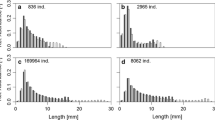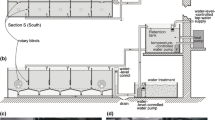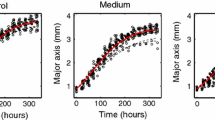Abstract
The distribution of the planktonic crustacean Daphnia pulex was tested in a ring-formedflow-through chamber divided into eleven sections. Thedistribution of the animals under both homogeneousfood conditions and in a food gradient were studied.The distribution of repeated registrations of singleanimals was randomly distributed in a homogeneous,low food environment. Single daphnids exposed to afood gradient tended to reside during 88% of the timeat the highest or next highest food concentration,suggesting that daphnids can detect food gradients.When a group of approximately 100 co-occurring animalswere given low homogeneous food conditions, they alsotended to be randomly distributed. In one out of threecases, however, they were slightly less aggregatedthan expected from a random distribution. Exposed toa food gradient (0.5–0.0015 mg C l-1), thedistribution of the daphnids approximated the idealfree distribution. A very high maximum density in thefood gradient (2 mg C l-1) resulted in less strongaggregations than expected from the ideal freedistribution.
Similar content being viewed by others
References
Cuddington, K. M. & E. McCauley, 1994. Food-dependent aggregation and mobility of water fleas Ceriodaphnia dubiaand Daphnia pulex. Can. J. Zool. 72: 1217–1226.
Fretwell, S. D. & H. J. Lucas, 1970. On territorial behavior and other factors influencing habitat distribution in birds. Acta Biotheor. 19: 16–36.
Godin, J. G. J. & M. H. A. Keenleyside, 1984. Foraging on patchily distributed prey by a cichlid fish (Teleostei, Cichlidae): a test of the ideal free distribution theory. Anim. Behav. 32: 120–131.
Harper, D. G. C., 1982. Competitive foraging in mallards: ‘ideal free’ ducks. Anim. Behav. 30: 575–584.
Jakobsen, P. J. & G. H. Johnsen, 1987. Behavioural response of the waterflea Daphnia pulexto a gradient in food concentration. Anim. Behav. 35: 48–52.
Kleiven, O. T., P. Larsson & A. Hobæk, 1996. Direct distributional response in Daphnia pulexto a predator kairomone. J. Plankton Res. 18: 1341–1348.
Larsson, P. & K. T. Kleiven, 1996. Food search in Daphnia. In Lenz, P. H., D. K. Hartline, J. E. Purcell & D. L. Macmillan (eds), Zooplankton: Sensory Ecology and Physiology, Gordon and Breach Publishers, Amsterdam: 375–387.
Milinski, M., 1979. An evolutionary stable stable feeding strategy in sticklebacks. Z. Tierpsychol. 51: 36–40.
Neary, J., K. Cash & E. McCauley, 1994. Behavioural aggregation of Daphnia pulexin response to food gradients. Funct. Ecol. 8: 377–383.
Smith, K. C. & E. R. Macagno, 1990. UV photoreceptors in the common eye of Daphnia magna(Crustacea, Branchiopoda). A fourth spectral class in single ommatidia. J. Comp. Physiol. A 166: 597–606.
Sokal, R. R. & F. J. Rohlf, 1981. Biometry. (2 ed.), W. H. Freeman and Company, San Francisco: 859 pp.
Young., S., 1974. Directional differences in the colour sensitivity of Daphnia magna. J. exp. Biol. 61: 261–267.
Author information
Authors and Affiliations
Rights and permissions
About this article
Cite this article
Larsson, P. Ideal free distribution in Daphnia? Are daphnids able to consider both the food patch quality and the position of competitors?. Hydrobiologia 360, 143–152 (1997). https://doi.org/10.1023/A:1003128315850
Issue Date:
DOI: https://doi.org/10.1023/A:1003128315850




